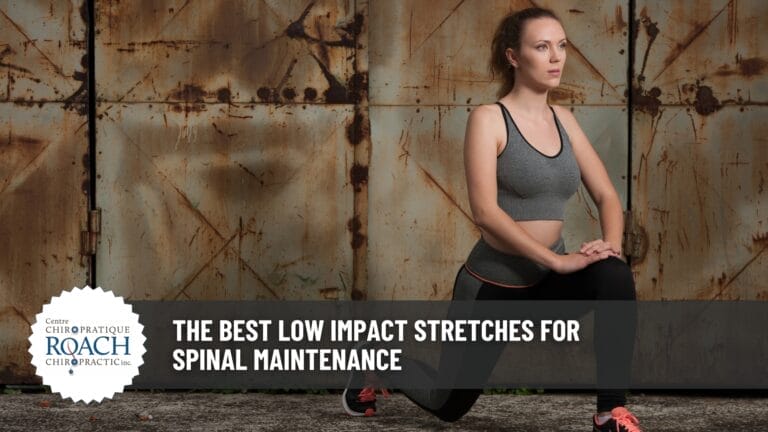Ways Nova Scotia Weather Influences Spine and Pain Levels

Can the weather really affect my spinal health?
Nova Scotia’s changing weather can significantly impact spinal health by affecting posture, joint pain, and overall discomfort. Patients in Bedford, Halifax, and Dartmouth often report that cold temperatures, high winds, and humidity lead to stiffness, pain, and flare-ups of arthritis and other joint conditions. This article explores how weather conditions in Nova Scotia affect spine health, why posture may suffer during extreme weather, and natural pain relief techniques. As a Chiropractor and Wellness Advisor at Roach Chiropractic in Bedford, NS, I share pain management strategies, exercise tips, and lifestyle modifications to reduce inflammation and improve spinal alignment. You will learn about environmental triggers for joint and spine pain and discover practical solutions—from proper posture and home exercises to when to seek professional chiropractic care.
How Does Nova Scotia’s Weather Influence Joint Pain and Arthritis?
Nova Scotia’s weather can directly increase joint pain in patients with arthritis and other chronic conditions. Changes in atmospheric pressure, temperature, and humidity can alter how joints respond, often increasing discomfort and stiffness. Lower barometric pressure and higher humidity levels have been linked to heightened inflammation in joints, worsening symptoms in conditions like psoriatic arthritis and rheumatoid arthritis.
What Role Does Humidity Play in Increasing Joint Pain?
High humidity can cause soft tissue swelling around joints, intensifying pain. Studies indicate that individuals with joint conditions might experience about a 10% rise in pain perception during long periods of high humidity. This effect can impact knees, hips, and even trigger flare-ups in people with neuropathy or inflammatory conditions. Therefore, it is important for patients to monitor humidity and embrace Chiropractic therapies such as Active Release Technique (ART). This is a way of stretching the muscle in an active way where patient bring the joints through an active range of motion followed by a passive push by the chiropractor at the end to bring the joint even further. Laser Therapy is also an excellent option – Learn more about our Theralase Laser Therapy here.
How Do Cold Temperatures Affect Arthritis Symptoms?
Cold weather can worsen arthritis symptoms by tightening muscles and reducing joint mobility. As tissues contract in low temperatures, pressure on the synovial fluid increases, making joint movement less effective. Many patients notice a clear surge in stiffness and pain in colder weather, which may disrupt daily activities. Chiropractic care and gentle warm-up exercises can help counteract these effects.
Which Weather Patterns Trigger Flare-Ups in Spine-Related Arthritis?
Rapid changes in temperature and atmospheric pressure can trigger flare-ups along the spine. Sudden drops in barometric pressure affect intervertebral discs and nerve roots, intensifying pain. Wind chill during winter may increase muscle tension and spasms. Recognizing these patterns means patients can preemptively schedule stretching sessions to lessen these flare-ups.
What Are the Best Posture Tips for Cold Weather in Nova Scotia?

Proper posture becomes even more important during Nova Scotia’s cold months to reduce pain and support a healthy spine. Cold temperatures can cause shoulders to slump and the head to droop forward, worsening joint stiffness and pain. The following strategies—from ergonomic adjustments to targeted exercises—can help maintain better spinal alignment.
How Can You Adjust Your Posture to Combat Cold Weather Stiffness?
Consciously engaging your core while sitting or standing supports spinal alignment and prevents slumping. Maintaining an upright posture with relaxed, pulled-back shoulders helps counteract the natural hunch induced by cold weather. Using ergonomic chairs and supportive cushions at home can further correct posture and ease tension.
What Home Exercises Improve Posture During Winter Months?
Exercises that strengthen the back, shoulders, and core are key. Pilates, yoga, and simple stretches such as chin tucks, seated rows, and wall angels reinforce proper alignment. Regular exercise keeps muscles flexible, reducing stiffness and chronic pain. A consistent routine can lower pain levels and support overall spinal health.
How Does Wearing Proper Clothing Help Maintain Spinal Alignment?
Proper clothing helps maintain muscle warmth and reduces spasms. Insulated, well-fitted garments—such as thermal base layers paired with supportive outerwear—keep muscles functioning optimally. Accessories like scarves and gloves help regulate body temperature and prevent overall tension, indirectly supporting spinal alignment.
How Can You Manage Seasonal Back Pain Caused by Nova Scotia Weather?
Managing back pain during harsh Nova Scotia winters requires addressing both environmental triggers and lifestyle factors. A multifaceted approach that includes physical therapy, home remedies, and daily adjustments can reduce inflammation and enhance spinal mobility.
What Are Effective Pain Relief Techniques for Winter Back Pain?
Combining hot and cold therapies is often effective. Using a heating pad can boost blood flow and ease muscle stiffness, while cold compresses help reduce inflammation. Mindfulness meditation and deep breathing exercises assist in lowering stress-related tension. Many patients also benefit from regular sessions combined with home stretching routines, which together can lower pain by noticeable margins.
How Does Weather-Related Stress Impact Spine Pain Levels?
Stress from harsh weather conditions can intensify spine pain by increasing muscle tension and raising cortisol levels. The mental strain caused by unpredictable weather is known to amplify physical discomfort. Managing stress through relaxation techniques, counseling, and routine exercise has been shown to reduce pain intensity significantly.
When Should You Seek Professional Care for Weather-Related Spine Pain?
If home interventions fail to relieve back pain or if the discomfort lasts more than three weeks or is accompanied by numbness or tingling, it is important to consult a chiropractor. Early professional intervention is crucial for conditions like herniated discs or severe osteoarthritis to prevent long-term damage.
What Spine Health Tips Are Essential for Nova Scotia Winters?
To protect the spine during harsh winters, it is essential to adopt healthy habits. Key tips include staying active, maintaining hydration, following proper nutrition, and making lifestyle modifications tailored to the colder months. These practices help maintain flexibility, reduce joint inflammation, and support overall posture.
How Does Staying Active Help Protect Your Spine in Cold Weather?
Regular physical activity improves circulation and muscle flexibility—a critical factor in maintaining a robust spine. Low-impact activities like walking, swimming, or using an elliptical machine help maintain bone density and muscle strength. Moderate exercise can also ease joint pain and improve function in patients with arthritis and other inflammatory conditions.
What Lifestyle Changes Can Reduce Weather-Related Spine Issues?
A balanced diet rich in anti-inflammatory foods, omega-3 fatty acids, and vitamin D supports joint and bone health. Getting adequate sleep and managing stress through mindfulness can also aid recovery and repair. Moreover, avoiding long periods of inactivity by taking movement breaks throughout the day helps reduce stiffness and improve spinal function.
How Important Is Hydration for Joint and Spine Health in Winter?
Even in cold weather, proper hydration is essential to maintain the lubrication of joints and the circulation of nutrients in the spine. Dehydration can reduce disc volume and increase the risk of degeneration. It is recommended to aim for at least eight 8-ounce glasses of water per day, which helps support cartilage repair and overall spinal health.
How Does Weather Affect Posture and Joint Health Throughout the Seasons?
Seasonal weather changes influence both posture and joint function. In humid conditions, moisture can lead to swelling and a tendency to slouch, while in dry conditions, reduced lubrication may cause stiffness and a rigid posture. Understanding these differences helps patients adjust their routines and setups to mitigate adverse effects.
What Are Common Posture Changes in Humid vs. Dry Conditions?
In high humidity, individuals often develop a forward head posture and rounded shoulders due to muscle relaxation and joint swelling. In contrast, dry weather can lead to a stiff, upright posture that may strain the lower back and neck. Adjustments such as ergonomic chairs or lumbar cushions can help maintain a balanced posture in both conditions.
How Do Seasonal Weather Shifts Impact Joint Flexibility and Pain?
Extreme cold can tighten joint capsules and limit motion, while a rapid change in temperature combined with increased humidity often triggers flare-ups in arthritis. Moderate warmth generally supports better flexibility and smoother joint movement. Even a small change in temperature can affect joint lubrication and comfort, highlighting the need for proactive self-care during transitions.
What Preventative Measures Can Minimize Seasonal Spine Problems?
Regular stretching, maintaining an ergonomic workspace, and staying physically active are key preventative measures. Daily stretching exercises targeting the back and neck can counteract the tightening effects of cold weather. Using supportive bedding and adjusting workstations to promote good posture further minimize the impact of seasonal changes. During rapid weather shifts, short-term use of over-the-counter pain relievers may be beneficial alongside long-term lifestyle adjustments.
What Are the Signs That Nova Scotia Weather Is Affecting Your Spine?

Early detection of weather-related spine issues is crucial. Patients may notice subtle changes in posture, increased joint pain, or stiffness during rapid weather shifts. Recognizing these signs early allows for timely adjustments to prevent more serious problems.
How Can You Identify Weather-Related Posture Changes?
Common indicators include increased rounding of the shoulders or a forward head posture, especially in cold or humid conditions. Simple self-assessment techniques—like comparing photos over time or using a posture app—can help detect these gradual shifts, prompting corrective exercises or ergonomic changes.
What Symptoms Indicate Weather-Triggered Joint Pain?
Symptoms to watch for include sudden stiffness, aching, or a dull, throbbing pain in the spine and adjacent joints after exposure to cold or windy conditions. These signs, if recognized early, can encourage patients to adopt measures such as warming up or targeted stretching to alleviate pain.
When Is Weather-Related Spine Pain a Medical Concern?
While mild discomfort is common, persistent pain lasting several days or associated with numbness, tingling, or radiating sensations should be evaluated by a medical professional. Early intervention can help prevent long-term damage and tailor treatment to individual environmental triggers.
How Can Chiropractic Care Help With Weather-Related Spine Issues?
Chiropractic treatments address both the symptoms and underlying causes of weather-related spine pain. These approaches restore proper spinal alignment, reduce inflammation, and improve mobility, helping patients manage pain more effectively during seasonal changes.
What Treatments Address Cold Weather Posture and Pain?
Chiropractic treatments such as spinal adjustments, Active Release Technique (ART), myofascial release, and laser therapy can relax tightened muscles and reduce pressure on joints. Combined with exercises that strengthen the core and enhance balance, these treatments improve posture and reduce pain during cold weather.
How Do Exercises Improve Joint Health in Changing Weather?
Specific routines – like dynamic warm-ups, resistance band exercises, and balance drills – help maintain joint flexibility and strength in low temperatures. These exercises boost blood circulation, aid nutrient delivery, and diminish inflammation, making them a vital component of an overall treatment plan.
What Role Does Patient Education Play in Managing Weather Effects?
Educating patients on the link between weather and pain empowers them to take preventive actions. Learning proper ergonomics, exercise routines, hydration habits, and the importance of regular breaks can significantly improve pain management. Informed patients are more likely to adopt strategies that reduce their symptoms and enhance long-term outcomes.
Want access to a completely free resource of valuable information, including detailed exercises and self-care guides?
Frequently Asked Questions
Q: How does cold weather exacerbate joint pain? A: Cold weather causes muscles to contract and tissues to tighten, increasing pressure on joints and reducing mobility, which can result in higher pain levels.
Q: What simple exercises can help improve posture in winter? A: Exercises like chin tucks, shoulder blade squeezes, and wall angels strengthen core and back muscles, reducing stiffness and supporting proper posture.
Q: Can proper nutrition impact joint and spine health during winter? A: Yes, a diet rich in anti-inflammatory foods, omega-3 fatty acids, and vitamin D supports joint lubrication and bone strength.
Q: When should someone seek professional care for weather-related spine pain? A: If pain lasts more than three weeks or is accompanied by numbness or tingling, professional care is recommended to prevent long-term damage.
Q: How can hydration affect spinal health in winter? A: Staying hydrated preserves the water content in intervertebral discs and joint cartilage, reducing the risk of disc degeneration.
Q: Do chiropractic treatments offer long-term relief for weather-induced spinal issues? A: Regular chiropractic adjustments help restore alignment, reduce muscle tension, and build resilience against recurring issues.
Q: What lifestyle changes can support joint health during seasonal shifts? A: Maintaining a regular exercise routine, eating an anti-inflammatory diet, staying hydrated, and using ergonomic furniture can help manage pain and maintain mobility.
Table: Key Weather Factors and Their Impact on Spine Health
Before diving into treatments, consider the following summary of weather factors affecting spine health:
Table: Home Remedies and Professional Interventions for Spinal Health
The following table outlines remedies and interventions to help mitigate weather-related spine issues:
By integrating these proven strategies into daily routines, patients in Nova Scotia can better manage the challenges posed by harsh weather and protect their spine health.
SHARE THIS






